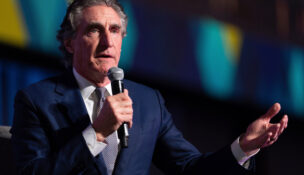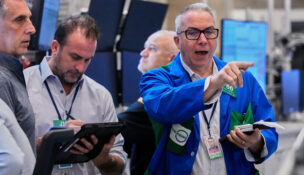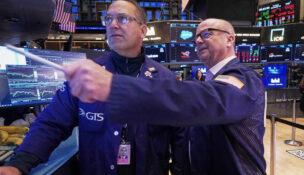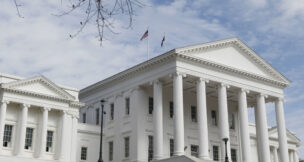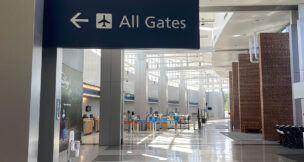Barkin: Trump policies are creating feelings of instability
Richmond Fed CEO highlights uncertainty about tariffs under new administration
Josh Janney //March 27, 2025//

Tom Barkin, president and CEO of the Federal Reserve Bank of Richmond, spoke at Washington & Lee on March 27, 2025. Photo courtesy W&L

Tom Barkin, president and CEO of the Federal Reserve Bank of Richmond, spoke at Washington & Lee on March 27, 2025. Photo courtesy W&L
Barkin: Trump policies are creating feelings of instability
Richmond Fed CEO highlights uncertainty about tariffs under new administration
Josh Janney //March 27, 2025//
Changes in federal government policy have created a sense of instability, Federal Reserve Bank of Richmond President and CEO Tom Barkin said Thursday when discussing the year’s economic outlook.
During a lecture at Washington and Lee University in Lexington, he said that at the end of 2024, businesses were “overwhelmingly optimistic” and conditions looked “rosy.” He noted that the nation’s GDP had grown a healthy 2.5% in 2024, unemployment was at 4.1%, and the 12-month Personal Consumption Expenditures Price Index, which captures inflation, had come down considerably to 2.6% from its peak of 7.2% in June 2022. Furthermore, small business optimism had surged, with an expectation of business-friendly policies under President Donald Trump, Barkin said.
However, that brief burst of optimism has dissipated now that Trump has returned to office and issued a flurry of tariff increases and cutbacks on federal spending and the federal workforce. That has placed federal government policy at center stage, and not in a positive way, according to Fed stats.
In the near term the fast pace of change “seems to have created a sense of instability,” and “the feeling of uncertainty is undeniable,” Barkin said. “Business optimism has dropped. Consumer sentiment has fallen. The March edition of the Fed’s Beige Book, which summarizes each reserve bank’s outreach on economic conditions, literally broke the record for mentions of ‘uncertainty.'”
But there is “some certainty” that the country is likely headed toward more tariffs, lower net migration, an extension of the 2017 tax cuts, as well as deregulation, lower growth in government spending and more efforts to promote traditional energy sources — i.e. fossil fuels.
Barkin said it remains to be seen how far these efforts will go, how they will net out and when they will land with enough clarity for participants in the economy to act. So far, some of Trump’s tariffs have been postponed at the last minute, such as a 25% tariff on goods coming into the United States from Mexico and Canada, which was supposed to go into effect March 4 and then was paused until April 2. However, a 25% tariff on steel and aluminum imports took effect March 12, and a 10% increase of tariffs on Chinese goods are in effect. This week, the president said he plans to enact a 25% tariff on all foreign-made auto parts and imported vehicles beginning April 3.
“This time around, if we assume an eventual 20% tariff on China and a 25% tariff on Mexico, Canada and aluminum and steel products, the average tariff rate rises almost four times more than in 2018,” Barkin said. “In the context of recent high inflation, one could imagine more of an impact on prices, but no one knows where the tariff rates will finally settle or how affected countries, businesses and consumers will respond.”
Regarding immigration, he said forecasters expect lower net migration to lead to slower workforce growth in the coming years — roughly about half the growth seen during the 2010s and a third of what was seen at the nation’s peak during the Biden administration. He said slower workforce growth could put downward pressure on economic growth and upward pressure on wages.
“But these stats are based on assumptions; no one knows what immigration will be in fact,” he said.
According to Barkin, deregulatory efforts could boost productivity, enable growth and lower inflation. However, he said the impact of government spending and workforce cuts would be outsized in his district, which covers South Carolina, North Carolina, Virginia, Washington, D.C., West Virginia and Maryland, as federal employment represents only 2% of the national workforce but a fourth of D.C.’s.
While Barkin said there is a lot “we know” in the minds of consumers and businesses, “that knowledge is being swamped by what they don’t know and by uncertainty around when they’ll finally have more certainty on the path forward.”
He said the sentiment of uncertainty is exacerbated by people consuming media all the time, never missing headlines.
“With all this change, a dense fog has fallen,” Barkin said. “It’s not an everyday ‘forecasting is hard’ type of fog. It’s a ‘zero visibility, pull over and turn on your hazards’ type of fog.”
As a result, he said businesses aren’t willing to take many risks today, neither pulling back nor pushing forward. He said nonprofits, hospitals and universities are feeling trepidation over federal spending changes as well, and manufacturers with supply chains in tariffed countries are expressing the most uncertainty.
“Sentiment matters,” Barkin said. “For consumers and businesses to spend and invest, they need to have a certain level of confidence. For credit and equity markets to finance those investments, they need stability. And, for now, an uncertainty-driven drop in sentiment looks like it could quiet demand. The outlook once the fog lifts will in part depend on how long it lasts.”
l

